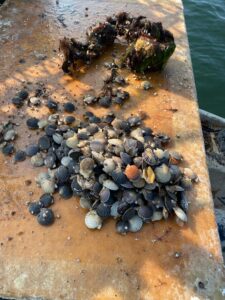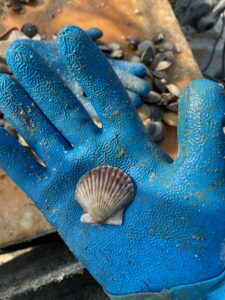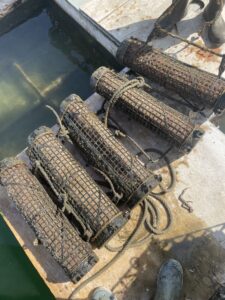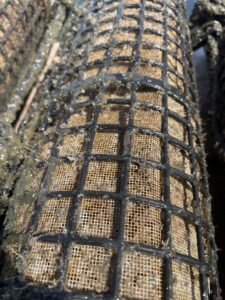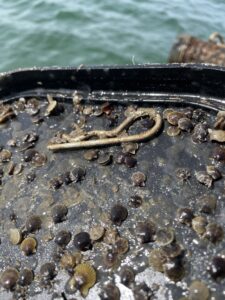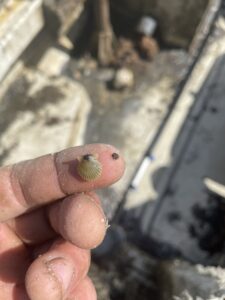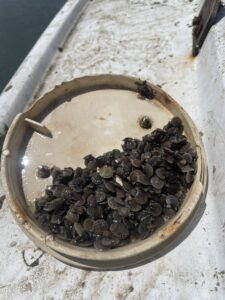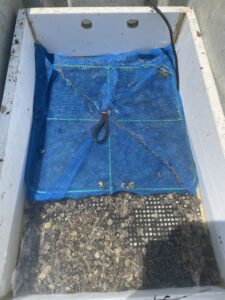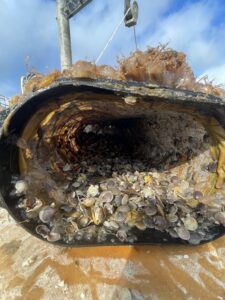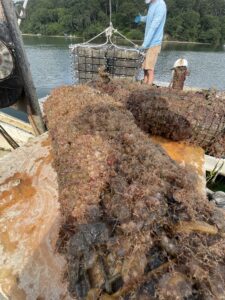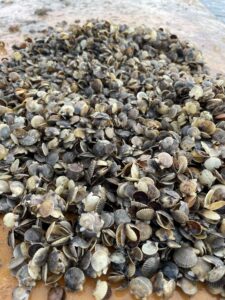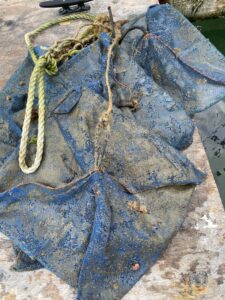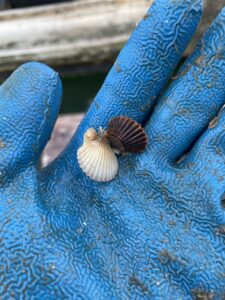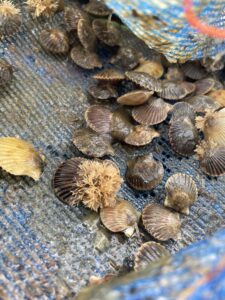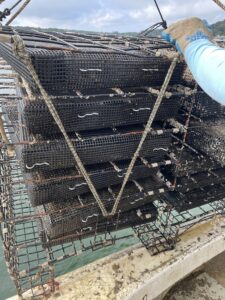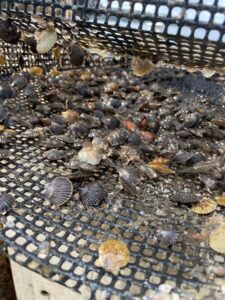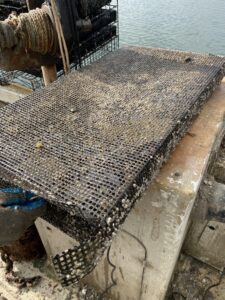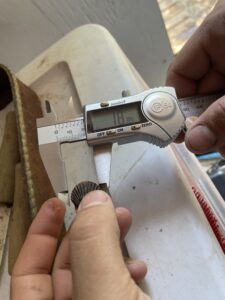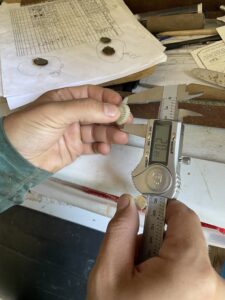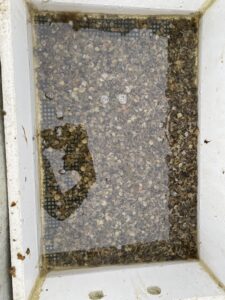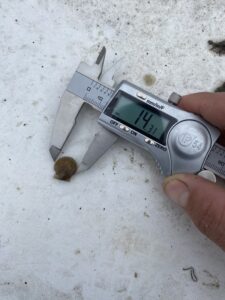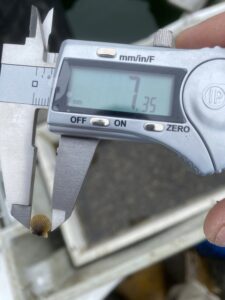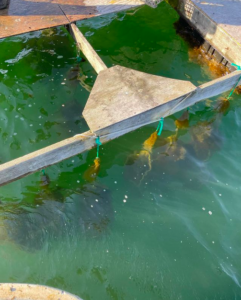Progress report for FNE23-058
Project Information
This project seeks to compare bay scallop growth in two common oyster growout gear methods; bottom cage culture and lantern/pearl net culture.
Year One:
- Acquire Bay Scallop seed from the MV hatchery and deploy into our upweller nursery system.
- Grow seed to 1/4” size for planting into grow out gear trials
- Move seed to both grow out gear types as it comes to size
- Bi-monthly photo/measurement documentation of growth size in each gear type
- At EOY we will compile all data into a report and publish to our outlets
Year Two:
- Continue Year One stock Bi-monthly photo/measurement documentation of growth size in each gear type
- Begin to harvest some of the Year One product for market
- Allow Year One stock to grow until natural mortality (Winter of year two)
- At EOY we will compile all data into a report and publish results to our outlets.
The current problem with most shellfish aquaculture operations in the USA is that they are single product farms, predominately growing only oysters. There is a huge need for second and third crops on aquaculture farms to help diversify income streams and protect against crop collapses. Bay Scallops have strong market demand and have provided income to fishermen for decades. The recent demise of bay scallop habitat and wild stocks have created supply and demand issues, driving the fishing industry into collapse while the cost of bay scallops soar to record levels. This presents a wonderful opportunity for aquaculture farms to generate bay scallop supply to meet the growing demand, while also aiding in the restoration of wild stocks.
Bay Scallops are native to the Cape and Islands and New England coastal sub-tidal waters. Their traditional harvest dates occur in the winter months to allow for the wild stock to propagate. Most market bay scallops are frozen in the winter months and thawed in the tourist filled summer months to meet high demand. Aquaculture reared bay scallop seed will be provided by a hatchery, allowing the wild stocks a chance to restore. Harvests of aquaculture reared bay scallops can occur year-round. This year-round harvest opportunity allows for a fresher product to consumers, at peak consumption season, to supplement the farmer income. In addition, farmed bay scallops can potentially spawn, boosting wild stocks and helping to restore the wild bay scallop populations.
When compared to oysters, bay scallops are much more delicate and will require a greater handling of the grow gear. Our test trials of two commonly used oyster growing infrastructure will allow us to determine the best methods of rearing bay scallops to market and will allow our results to be duplicated easily by other farms across the New England area. Our report, trials, failures and successes will be shared with farmers via our social media network (over 3500 followers), a dedicated website, and a presentation at the Massachusetts Aquaculture Association annual meeting.
Opening the aquaculture industry to bay scallops is one of the most important opportunities the industry has seen to date. By far this is the largest opportunity I have seen in my fifteen years of farming. Farming bay scallops is a HUGE deal. Market demand is higher than oysters, and bay scallops are the missing second dependable farm crop that many of us farmers have been trying desperately to find. Historically, the bottleneck has been the hatchery source for bay scallop seed. After years of debate, the Martha's Vineyard shellfish hatchery has finally opened their bay scallop seed program to commercial farms. With the seed source finally secured and demand at record numbers, the golden time to begin bay scallop trials is now.
Our project and data will be the first of its kind and will aid all sub-tidal farmers with proper stocking densities and grow-out gear to be successful. Our reports will give growers around the region first class data results on the two most commonly used containers for shellfish farming and shine as a model for farmers to replicate with success.
Cooperators
- - Technical Advisor
- - Technical Advisor
Research
50,000 bay scallop seed will be acquired from the Martha’s Vineyard Shellfish Group at 1.6mm in size and grown to roughly 3mm in our existing upweller nursery system. As the seed reaches 3mm in size, we will measure seed with a ruler, photo document and count specific densities into the two types of culture containers; bottom cage grow bags and pearl/lantern nets. Each gear type container will be stocked with specific densities ( a group of containers with 75 scallops, a group with 100 scallops, and a group with 150 scallops). Each container will then be "planted" on the aquaculture farm.
Bi-monthly we will pull all gear from the water and measure with a ruler a sample from each container. Photos will document growth and biofouling, and data will be entered on a spread sheet. Once a month (on the second sample), all grow gear types will be cleaned to eliminate biofouling.
At the end of Year One, we will compile the data onto the website and prepare a presentation to give to all growers at the Massachusetts Aquaculture Association annual meeting.
Year Two we continue the growth monitoring and photo documentation. Bi-monthly we will pull all gear from the water and measure with a ruler a sample from each container. Photos will document growth and biofouling, and data will be entered on a spread sheet. Once a month (on the second sample), all grow gear types will be cleaned to eliminate biofouling. As product becomes market size, we can begin to harvest for the market. We will also continue growth trials until the product naturally dies (Winter of Year Two).
At the end of Year Two, we will compile the data onto the website and prepare a presentation to give to all growers at the Massachusetts Aquaculture Association annual meeting.
50,000 Bay Scallop seed was purchased from the MVSG and delivered to us on May 19th, 2023. The seed was placed into seapa bins with 1mm mesh liners and placed on our nursery raft in the lagoon. By 6/10 the baby scallops had doubled in size and on july 5th we measured the scallops before moving them into their grow out containers. Scallops measured between 14mm and 7mm. Half of the scallops were stocked into mid water mesh bags, while the other half were stocked into 1/4" mesh grow out bags, loaded into cages and placed in various depths on the lagoon pond farm site. Cage depth ranged from just 10ft below the surface to 40ft below the surface. Mesh bags were hung from a raft and descended down to various depths, from just 5ft below the surface all the way to 30ft below the surface. Stocking densities in each container were at 100 count (100 per bag or 100 per net). 2 containers of seapa seed was allowed to remain in the water to see if further growth could be achieved. On July 22nd, we checked on the seapa cages to find almost 100% mortality on the remaining seed. Cages had become overfouled, and the scallops had reduced to mortality for survival. The nets and oyster cages were also checked on July 22nd, and measurements were taken from both containers, with the average net sized scallop being 18mm, and cage bag size being 20mm. On September 2nd all of the gear was checked to find that scallops grown below 20ft of depth on the site had died due to anoxic conditions on the farm. This meant all cages below this depth, and all lantern nets below this depth experienced 100% mortality. Of the stock that survived, scallops showed great growth and survivability. At this time, the gear was exchanged for larger mesh, as the scallops could now be placed on standard 3/4" oyster bag mesh. The cage scallops were moved up to final growout size, and the mesh net scallops were moved up to a larger mesh final growout lantern net.
We sought to grow bay scallops from the hatchery to market size over a two year period.
In year one, we successfully grew bay scallops from the initial 1mm size delivered by the hatchery, to about 26mm (1 inch) size. Scallops have been tested in various container types and depths within the farm area throughout the growing season. Due to anoxic site conditions, about 50% of the initial 50,000 scallops have been killed. Those which were growing within the healthy environment have shown great success, with the pearl and lantern net method so far proving to be the most productive, efficient method of growth. Growth is expected to slow considerably in the winter months, and we will re-access mortality and growth rates in the Spring of year 2.
Education & Outreach Activities and Participation Summary
Participation Summary:
We have upcoming presentations to the Massachusetts Aquaculture Association members at the annual meeting, in which we will highlight our trials to date, and gather feedback on market opportunities and industry perspective.
In addition we have published current results to our website and social media sites.
Learning Outcomes
Being the first time any of us have trialed growing scallops, the entire process has thus far been engaging, insightful and an overall learning adventure. Unlike oysters, the scallops tend to show a wide range of "intelligence" inside the containers. We have noticed that they tend to evenly space themselves out within the containers, most likely to maximize their ability to filter, and we have also noticed that they will kill each other off if the densities are too much, most likely to give themselves room for growth.
The scallops are much more fragile than oysters, which reduces the ability to air dry containers to control fouling. Instead, we have opted to switch fouled gear with clean gear, a practice which takes considerable time when dealing with the pearl and lantern nets.
We are so far very happy with the results so far.
